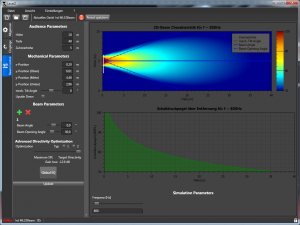hd LevelZ
Remote & Simulation Software
The hd MultiDSP open architecture platform guarantees perfect control over all relevant system components using the easy-to-use, windows based hd LevelZ remote software. This new DSP platform now enables all the processing and control functions of large sound systems in easy-to-use plug and play device.
The input section includes a routing matrix, a function generator (sine and noise generator), and 16 input channel IIR filters each, which can be configured as variable highpass / lowpass / allpass / peak / shelf / notch filters, and a 384 taps FIR filter. There are 16 IIR filters per output channel that can be configured as variable highpass / lowpass / allpass / peak / shelf / notch filters, 384 taps FIR filter, 100 ms delay, 180° phase inversion, peak limiter, RMS limiter, gain and mute available.
There are 20 factory presets for all Harmonic Design speaker system configurations stored for direct recall to the device so that it can always be reset to a defined default state of the system. This guarantees highest reliability of the connected speakers and ensures a very dynamic and linear sound. For user-specific settings, another 20 freely configurable user presets are available to save and manage individual configurations. With the software, the individual requirements can be discussed in more detail and unlimited user presets and configurations can be managed.
Reliable Prediction.
To adapt the beamforming loudspeaker to the specific venue it´s necessary to perform a simulation and tweak the beam parameters. Therefore a complete simulation tool has been integrated into the remote software hd LevelZ. Set the audience parameters like height, depth and listening height of the venue and place the speaker at the desired position with optional mechanical tilt angle. Lastly, give a rough estimate of the beam parameters and start to evaluate the 2D Beam-Plot and SPL over distance plot at various frequencies until the final settings have been derived.
Beam Steering.
Beam steering is the basic discipline of beam forming where the main lobe is digitally steered up- or downwards. Harmonic Design Beamforming loudspeakers are capable to adjust the vertically main lobe beam angle up to ± 60° with an accuracy of 0.1°/step.

main beam @ 0°

main beam @ +10°

main beam @ -32°
Frequency Independent Opening Angle.
Conventional loudspeaker arrays increase their directivity with increasing frequency resulting in a wide main lobe at low frequencies and a narrow main lobe at high frequencies. A frequency independent opening angle preserves the same opening angle over a great bandwidth within physical limitations and is adjustable from minimum to 90° in 0.1° steps. This guarantees perfect concentration of sound where it belongs and where not.

f = 800 Hz, conventional

f = 2 kHz, conventional

f = 4 kHz, conventional

f = 800 Hz, frequency independent

f = 2 kHz, frequency independent

f = 4 kHz, frequency independent
Multiple Beams.
The unique Harmonic Design Algorithm enables up to 4 separate main beams that can be steered individually and still create a specific frequency independent opening angle.

main beam @ 0°

2 beams @ +5°|-20°

3 beams @ +20°|-2°|-20°

4 beams @ 35°|+12°|-12°|-35°
AdvancedDirectivityOptimization.
The conventional beam radiation pattern also contains unwanted side lobes that excite the auditorium with disturbing noise while declining the speech intelligibility. By applying special algorithms to the individual DSP channels, an almost optimum, light-beam-like main lobe beam is achievable with an accurate side lobe suppression. The enhancements to improve speech intelligibility in reverberant rooms by applying ADO algorithm are extreme. The strength of the optimization tool may be adjusted by the end-user either towards maximum SPL or optimum target directivity.

conventional beam pattern, ADO off

intermediate ADO

maximum ADO
Focus.
By default the focus point of the wave fronts of the individual loudspeakers is infinity and creates parallel running pressure waves. At the distance infinity all wave fronts are perfectly correlated and coherent meaning they arrive at the same time with the same relative phase. Whenever this large throw is not necessary it may be useful to focus the wave fronts to the front rows in steps of 0.1m to tighten the „sweet spot“ .


